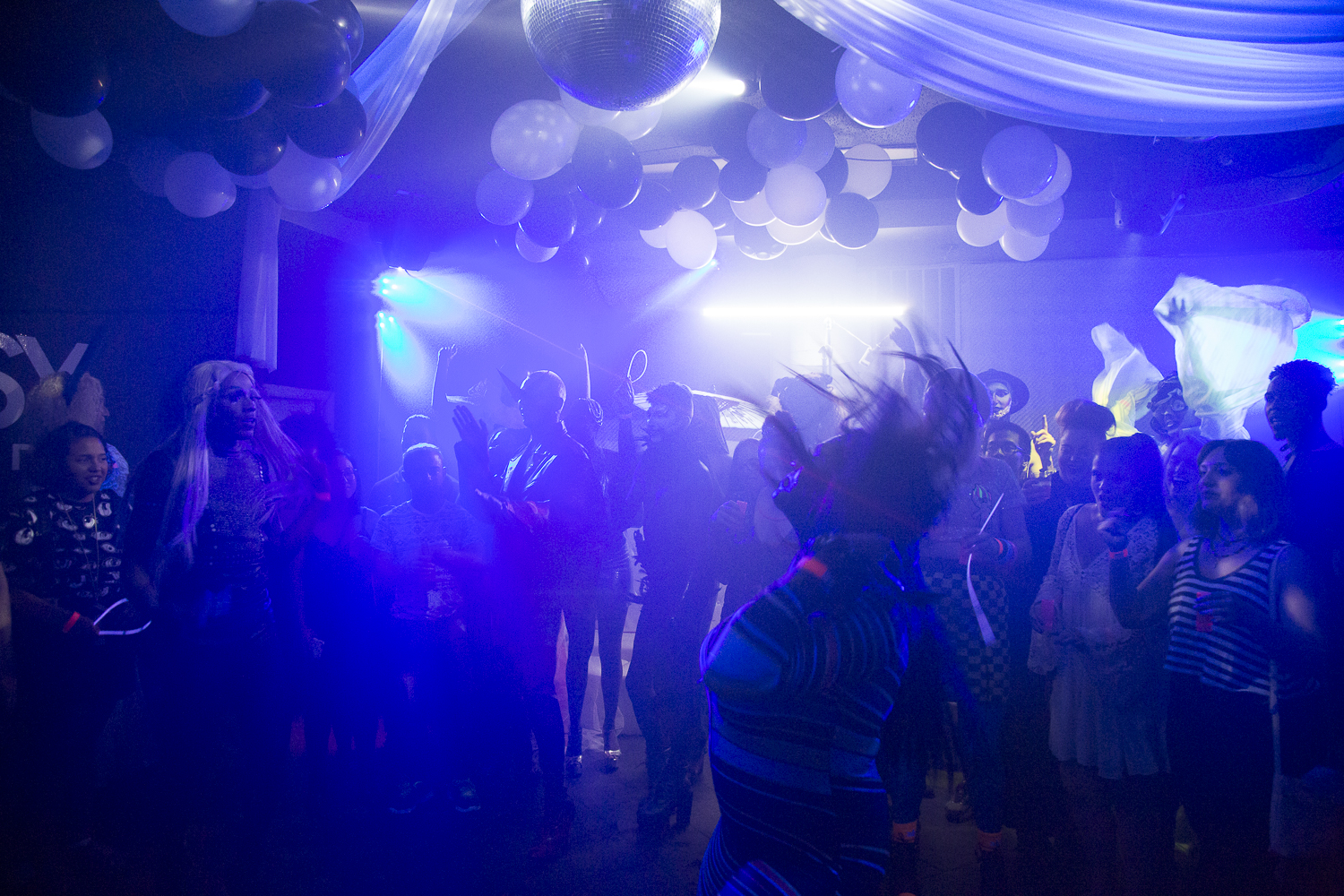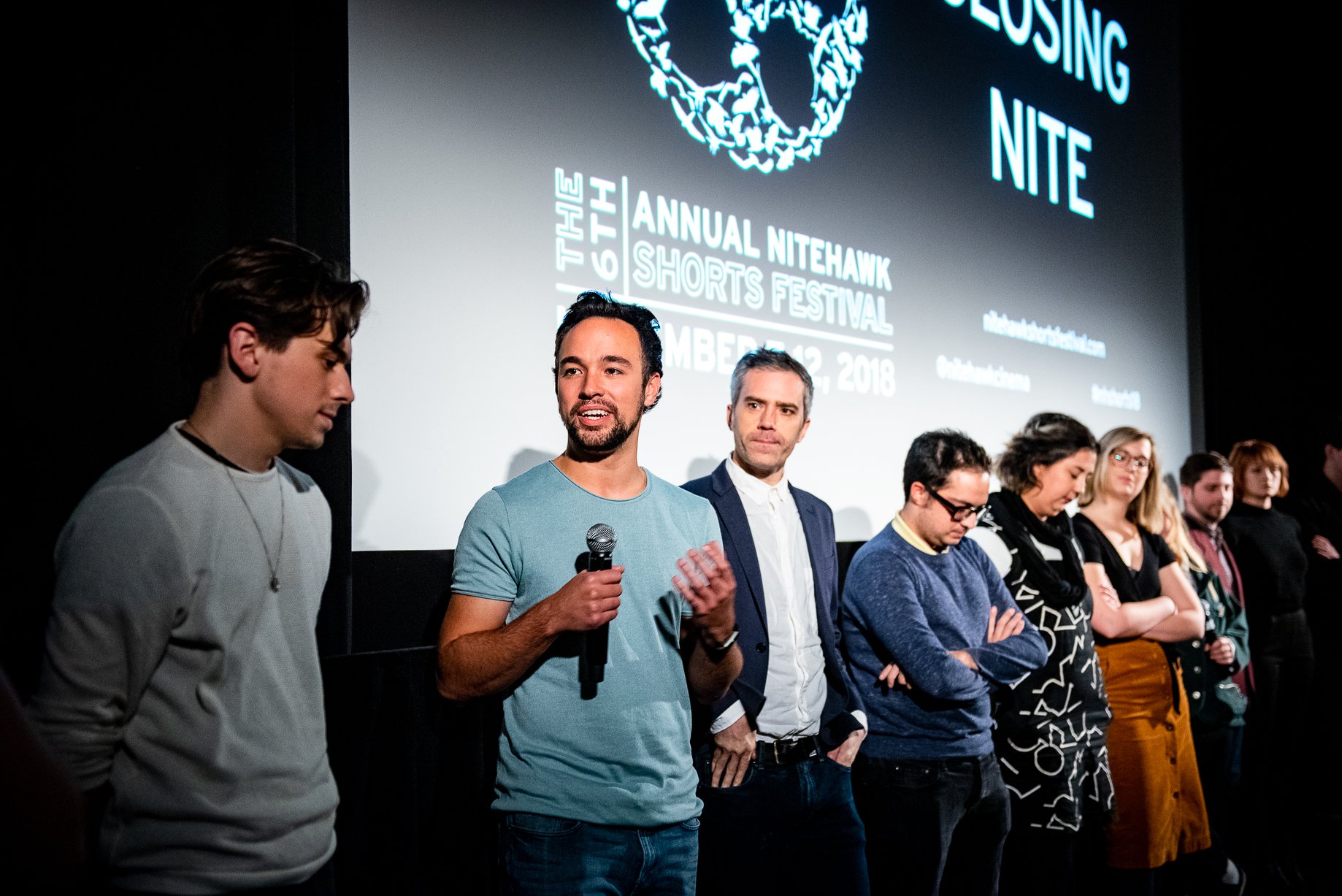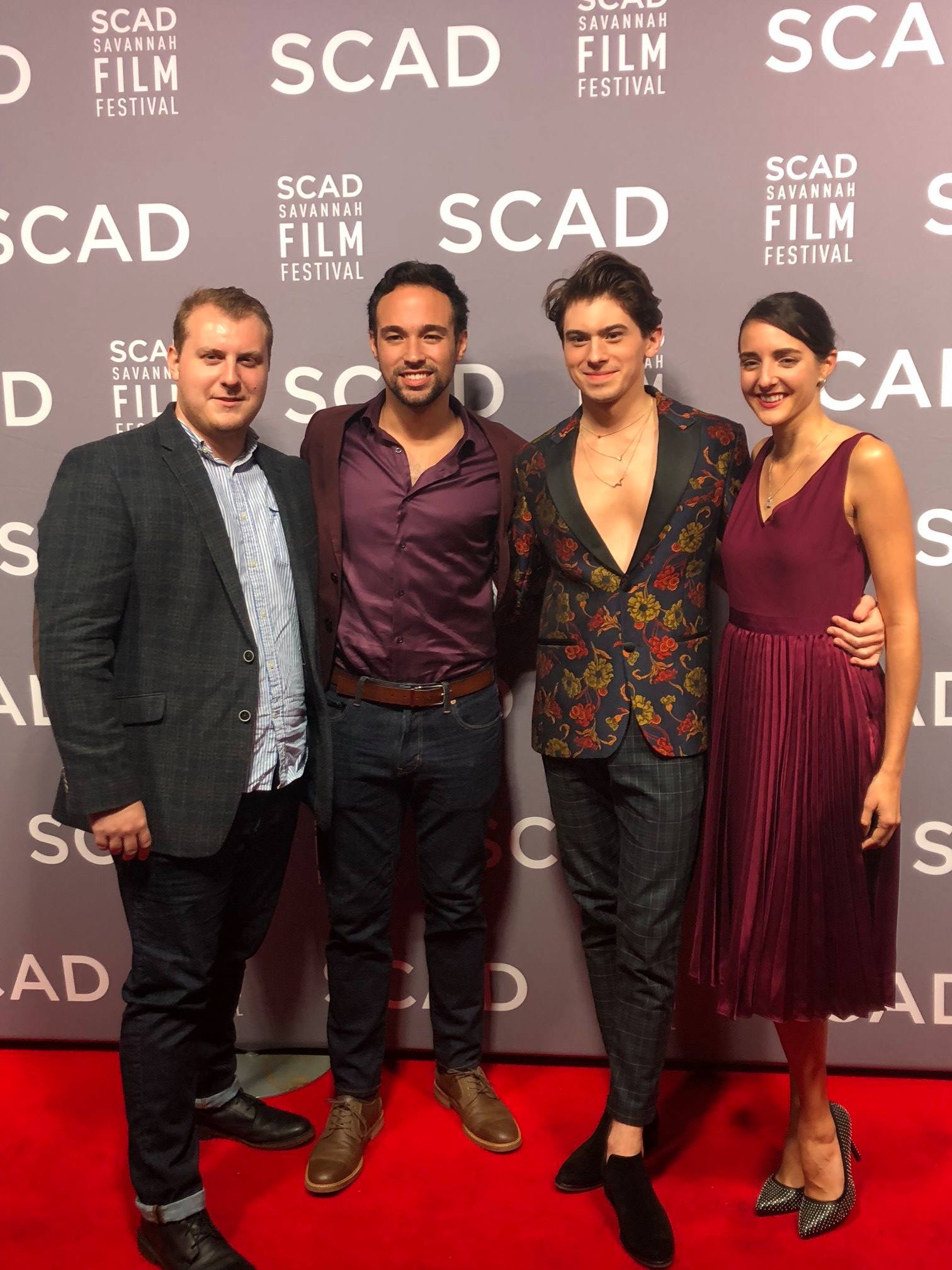Reflections on "Like Glass"
Andrew K. Meyer // Co-Founder, StoneStreet Cinema
It was Christmas Eve in 2016 when I read David Elijah’s short film screenplay, Like Glass. StoneStreet Cinema had just released The Nativitree that morning, its third short film in its sixth month of business.
When I reached that final 21st page, two things were immediately clear:
This was going to be an incredible film.
This was going to be near impossible.
There were large set pieces and even larger headpieces, beaches and clubs, violence and nuance, over a dozen locations and over two dozen actors. I wanted it so bad, and I thought I couldn’t have it. I told David that, but he asked to meet up regardless.
Enter Lauren Flack. My StoneStreet partner Christoph Plunkett, David and I were all sitting in the upstairs loft of the Public Theater, discussing the plausibility of this shoot. I’ll never forget that first meeting, right from when Lauren sat down with us. She said a bunch of fancy words, David said a bunch of fancy words, and they asked this dummy if he would direct the film if they produced it.
Of course he would, dummy.
sizzle, seed, & spark
The dream team was assembled. Lauren helmed the Executive Producer role and David became Creative Producer, on top of being its writer and playing the role of “Luke.” Chris was to be our cinematographer and editor, and we both became Associate Producers. The Core Four was formed.
We needed some money. A rather large amount of money for us, which, as it turns out, we did not have. So we made a plan: film a one-minute sizzle reel and raise the funds on Seed & Spark.
The sizzle reel was shot over one weekend in March 2017. We pooled together several actors and crew members and shot a “trailer” to sell our nonexistent movie. Wanna know the crazy thing? We shot it entirely in David’s apartment.
We slapped that sizzle reel onto our Seed & Spark profile, and within one month we raised the $10,000 we needed to get this thing on its long, luscious legs.
pre-production
Pre-production took place in many locations, holding meetings at the Public Theater, in the IKA Collective office, in Webster Hall and the Flash Factory, etc. We were building a crew, rehearsing the actors, studying club kid culture and location-scouting the entirety of Brooklyn. I built an extensive shot list with Chris and David right by my side, creating a unified vision one angle at a time.
From April to May we organized all sorts of details and solved all sorts of puzzles. The impossible began feeling more and more possible.
When the clock struck June, we were out of time. We were about to put Like Glass into a camera.
production
Like Glass was shot in five days, four in a row in June and one more in August…
Day 1: EXT. ALLEYWAY - 5:00pm-12:00am
Day 1 was a night shoot, nothing more than the alley scene at the climax of the film. I traveled on a Friday night from my New Jersey 9-5 job in real estate finance (long story) to the Brooklyn location, which was already filled with more people than I ever worked with on one set (outside of background “work” for Men in Black III, naturally).
I immediately felt ill-prepared. Actually, I was ill-prepared. That shot list we poured hours into wasn’t the only thing I needed to rely on. There were professionals who needed direction. There was a violent scene that needed choreography. I immediately felt like I was giving a book report knowing only the subject’s wikipedia summary.
But this crew lifted me right on track. Every single one of them did their part exceptionally, taking the smallest bit of instruction and turning it into art. Just like that, I found a tribe that I would continue working with for many projects to come.
Day 2: INT. DOWNTOWN BROOKLYN APARTMENT - 2:00pm-2:00am
We shot three key scenes between Jesse and David in four different rooms for twelve straight hours over the course of a hot summer afternoon and evening. It was very steamy, hot and intimate. Also, we shot a sex scene.
Day 3: INT. DAVID ELIJAH’S APARTMENT + EXT. JACOB RIIS BEACH - 12:00pm-9:00pm
Day 3 stretched from Cobble Hill’s garage confrontation scene to our sunset beach shoot at Jacob Riis Beach. We did not have the budget to permit the beach, so we shot around beachgoers to get Jesse laying half in the ocean or Magdalena trudging through sand on stilts. Chris, easy-rig strapped tight to his back, captured every angle we could think of of Jesse, David and Magdalena looking out into the ocean like a bunch of beautiful weirdos. It felt crazy when we were shooting it. It looked majestic when we looked back at it.
Day 4: INT. ANOTHER GUY NAMED DAVID’S APARTMENT + EXT. DAVID ELIJAH’S APARTMENT - 6:00pm-6:00am
Day 4 was a Monday, so after another 9-5 in the real estate sector (I don’t know what that means), I moseyed on back to Brooklyn for an all-nighter spent almost entirely in one apartment that would have felt large had it not been filled with over a score of us, half of whom were in heels.
Behind the camera was a labyrinth of c-stands and lighting rigs, piles of makeup and costumes, and a faint mist of glitter- all to be moved into different corners between each subsequent camera setup. We fell half-an-hour behind schedule. Then an hour behind. Then really behind. We had to shoot over three full scenes of dialogue and all the b-roll in the world. But by 5am, we had somehow caught up, just in time to hop in some vehicles and race to a nearby rooftop to film the final scene of the movie, a sunrise (can you tell we have a thing for golden hour?).
We got singles of Magdalena and Jesse, and then quickly mounted the camera on a dana dolly for our final shot.
The marathon was complete, four days in a row of shooting everything but the nightclub scenes. We all hugged and went to work. It was Tuesday morning, after all.
Day 5: INT. XSTASY BAR AND LOUNGE - 4:00pm-9:00pm
Two months passed before we got to Day 5. I attended a wedding in Paris, David made a trip to Scotland and the whole project seemed to fade in and out of memory, for a brief moment. But the nearing club shoot was integral, it’s the location that is used to interweave the entirety of the film in its non-chronological structure. And we couldn’t find the location until just a few weeks before shooting in mid-August.
Xstasy Bar and Lounge is a tiny, easy-to-miss gay bar right across the street from the Greenwood Cemetery. They for some reason offered us the space, despite our fair warnings that we were about to transform the place entirely. We gathered a whole bunch of lights and over thirty extras, more than half of whom were in drag or full club kid looks.
When we arrived, the moving lights that were already inside the club, which were supposed to function, happened to not function at all. So Chris and our gaffer Ian had to last-minute build an entire look solely based on our own equipment, resulting in the blue and white color scheme that defines so much of this film now. We somehow shot all of the film’s most dramatic and exciting footage within the five short hours we were allotted, and Like Glass was finally wrapped.
post production
By the time we had finished our fifth and final shoot day, Chris and I had already cut much of what we shot in June into rough individual scenes. Weaving it all together with the club footage was like a masterclass in editing. Because of the film’s lack of chronology, we found ourselves shifting the structure of the narrative over and over again, cutting scenes that we loved and others that worked better on paper to get us way under the 25 minutes we landed on in its first full cut.
From August to November, I experienced two affairs of the heart: one with our composer Nathan Prillaman and the other with the Portugal-based Pulsar Studios, a post-production sound studio run by Tiago Cardoso and Dinis Henriques. Nathan was tasked with composing a blend of classical and club music, recording professional cellists and producing heart-thumping bass lines. Tiago and Dinis meanwhile created the most elaborate soundscape, one in which I notice a little something new each time I listen to the film. Nathan, Tiago and Dinis all brought something to the table that somehow outweighed their talents- their own love of cinema. Not a late-night Skype session went by that didn’t end with Tiago and I breaking down our favorite hot-take on any random film, new and old. I always miss my time with them.
In November 2017, we had finally completed Like Glass. In December, a full year since I read that first draft, we unveiled it to our cast, crew, family and friends in a private, rowdy premiere at Anthology Film Archives.
The next step was to unveil it to the world.
The circuit
It took more than half of a year and a slew of rejections for Like Glass to get its first festival acceptance. We learned not to take it too personally. Not only was Like Glass an unusually long short film at a flat 20 minutes, but we were always up against a tide of great competitors, no matter the scale of the festival.
Our first acceptance brought us to a festival screening that took place in a small barn-like venue in Connecticut. They technically played Like Glass, only it was someone else’s film also titled “Like Glass”. None of us live in Connecticut, but five of us made the trip. It was technically hilarious.
After that, karma must’ve kicked in, for a dozen more Official Selections poured in. We all hopped around the country to show this baby off- I went to Newport Beach, David to Las Vegas & Boston, Lauren to Kansas City, etc. None of them beat the time that the Core Four and our three leads (Jesse, Magdalena and Ashton) all went to the SCAD Savannah Film Festival last October. We hunkered down in one of those beautiful Savannah homes that you see in the movies. And we, to put it lightly, tore up the town.
the end
Today it is June, in the year 2019. It has been just a few days over two years since we began rolling the cameras. Last week we were shooting some “Looking Back” interviews with the cast and crew. Next week we’ll be completely done promoting this. No more phone calls, or emails, or impromptu bar meetings. Just one long incomparable memory.
I’ve been looking back a lot lately. I was real was different when this started. I was more timid and much more uncomfortable in my own skin.
In December of 2016, after reading Like Glass by David Elijah, I immediately questioned my place in telling this story- the story of Zion, a non-binary person facing personal and community conflicts that are completely foreign to my own. For a script of this scale, I wondered if they chose the wrong person to direct. But David’s vision was that this narrative be told in terms both unique and universal. It was written for a specific group of individuals, with the intention to share it with everyone. Inclusivity is key.
I’m so privileged to have been included, for a million different reasons. For me, Like Glass was equal parts film school and life school. Before, I was just a guy who thought he had some good ideas. Now, I’m the same guy, but I don’t keep those good ideas to myself so much anymore. The world of Like Glass is one that encourages pride and self-worth. David and Lauren and Jesse and Magdalena and Ashton and Chris all encouraged that too. I owe this and them and everyone else everything.
It is impossible to imagine how it gets better from here, but allegedly, it somehow does.













